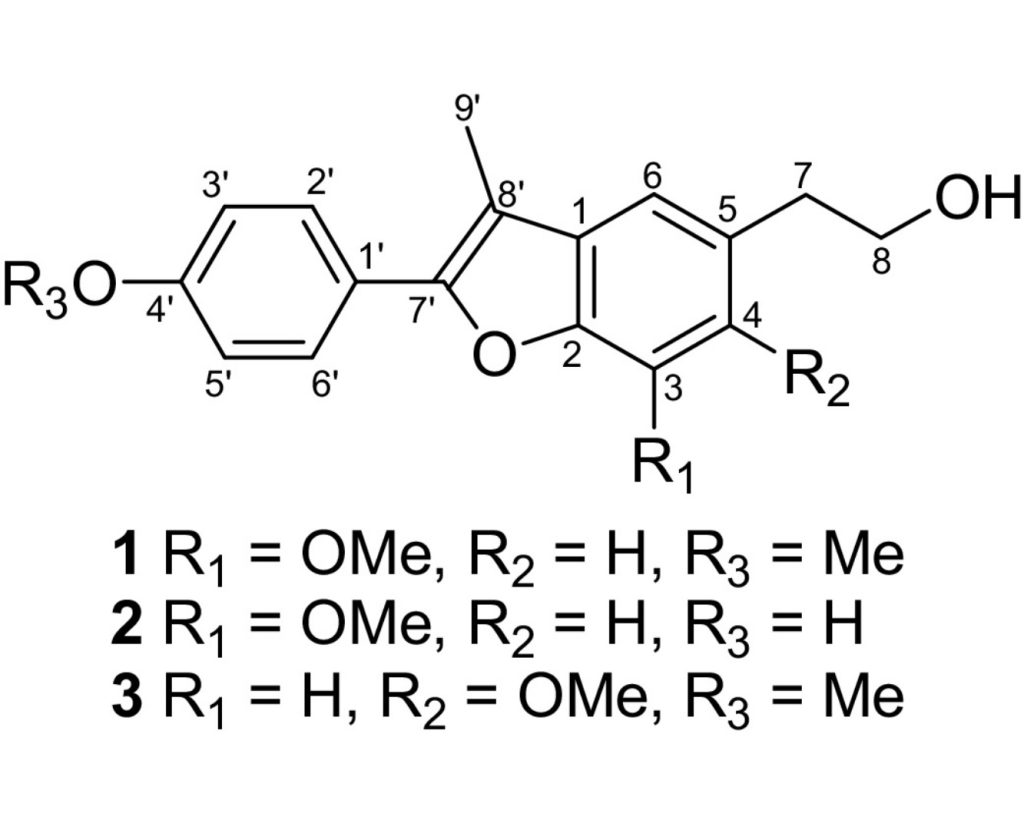DOI:10.1016/j.phytol.2016.12.005
Shiyun Tang 1, Jianlian Shi 1,2, Chunbo Liu 1, Fengmei Zhang 1, Nengjun Xiang 1, Xin Liu 1, Yongkuan Chen 1, Junheng You 1, Qinpeng Shen 1, Mingming Miao 1, Zhihua Liu 1, Guangyu Yang 1
1Key Laboratory of Tobacco Chemistry of Yunnan Province, China Tobacco Yunnan Industrial Co., Ltd, Kunming, PR China 2School of Pharmaceutical Science & Yunnan Key Laboratory of Pharmacology for Nature Products, Kunming, PR China
Abstract
Three new arylbenzofurans, 2-(7-methoxy-2-(4-methoxyphenyl)-3-methylbenzofuran-5-yl)ethanol (1), 4-(5-(2-hydroxyethyl)-7-methoxy-3-methylbenzofuran-2-yl)phenol (2), and 2-(6-methoxy-2-(4- methoxyphenyl)-3-methylbenzofuran-5-yl)ethanol (3), together with three known ones (4–6) were isolated from the whole plant of Lavandula angustifolia. Their structures were determined by means of HRESIMS and extensive 1D and 2D NMR spectroscopic studies. Compounds 1–3 and 5 were tested for their anti-tobacoo mosaic virus (TMV) activities, and Compounds 1–6 were tested for their cytotoxicity activities. In our assay, Compounds 1–3 showed high anti-TMV activity with inhibition rate of 38.2, 35.2, and 34.0%, which superior to positive control Ningnanmycin. Compounds 1–6 also showed weak inhibitory activities against some tested human tumor cell lines with IC50 values in the range of 2.2–8.2 μM.
Graphical abstract

Introduction
Lavandula angustifolia (L. angustifolia) Mill. is a perennial shrub of the family Lamiaceae. It originated in the southern Europe and the Mediterranean area, and is commercially cultivated in many countries L. angustifolia is also a very popular aromatic plant and commonly used for perfumes, cosmetics and medicines (Cavanagh and Wilkinson, 2002). In previous work, a number of bioactive compounds, such as flavonoids (Bajalan et al., 2016, Panuccio et al., 2016, Farhoudi and Lee, 2014), lactone (Lesage-Meessen et al., 2015), coumarins (Bourgaud et al., 2006, Haig et al., 2009, Areias et al., 2000), terpenes (Jullien et al., 2014, Demissie et al., 2011), fatty acids (Topcun et al., 2007), and the like, were isolated from the genus of this plants. Some of these compounds have showed various bioactivities, such as antimicrobial, antioxidant, fungistatic, antiviral and cytotoxicity. In this study, three new arylbenzofurans (1–3) and three known ones (4–6) arylbenzofurans were isolated from the whole plant of L. angustifolia. Their structures were identified by spectroscopic methods, including HRMS and 1D and 2D NMR. In addition, the anti-tobacco mosaic virus (anti-TMV) activity and cytotoxicity activities of these compounds were also evaluated.


